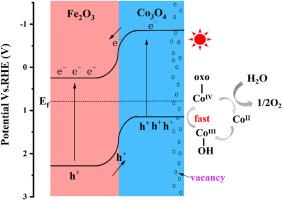Construction of highly efficient heterojunction photoanode Vo-Co3O4/Fe2O3 rich in oxygen vacancies for photoelectrochemical water splitting
IF 3.5
3区 化学
Q2 CHEMISTRY, INORGANIC & NUCLEAR
引用次数: 0
Abstract
Seeking effective strategies to enhance the photoelectrochemical O2 evolution activity of Fe2O3 photoanode remains a significant challenge due to poor conductivity, rapid recombination of photogenerated charge carriers and sluggish oxygen generation kinetics. Herein, we report the construction of a highly efficient heterojunction photoanode of Vo-Co3O4/Fe2O3 with rich oxygen vacancies via a combination of electrodeposition and solvothermal methods. The heterojunction formed between Co3O4 and Fe2O3 could effectively improves the separation efficiency and transfer process of photogenerated charge carriers. Additionally, the oxygen vacancies subsequently introduced by solvent heat treatment could improve the conductivity and lower the oxygen overpotential. As a result, the photocurrent density of Vo-Co3O4/Fe2O3 photoanode is up to 7.17 mA cm−2 at 1.23 vs. RHE, which is 358 times higher than that of pristine Fe2O3 photoanode (0.02 mA cm−2). This substantial enhancement in PEC O2 evolution activity can be attributed to the synergistic effect of heterojunction construction and the introduction of oxygen vacancies.

高效富氧空位的Vo-Co3O4/Fe2O3异质结光电阳极的构建
由于Fe2O3光阳极的导电性差、光生载流子的快速重组和氧生成动力学缓慢,寻求有效的策略来增强其光电化学析氧活性仍然是一个重大的挑战。在此,我们报道了通过电沉积和溶剂热相结合的方法,构建了一个具有富氧空位的Vo-Co3O4/Fe2O3的高效异质结光阳极。Co3O4与Fe2O3之间形成的异质结可以有效地提高光生载流子的分离效率和转移过程。此外,溶剂热处理后引入的氧空位可以提高电导率,降低氧过电位。结果表明,在1.23 vs. RHE条件下,Vo-Co3O4/Fe2O3光阳极的光电流密度高达7.17 mA cm - 2,是原始Fe2O3光阳极(0.02 mA cm - 2)的358倍。PEC O2演化活性的显著增强可归因于异质结构建和氧空位的引入的协同效应。
本文章由计算机程序翻译,如有差异,请以英文原文为准。
求助全文
约1分钟内获得全文
求助全文
来源期刊

Journal of Solid State Chemistry
化学-无机化学与核化学
CiteScore
6.00
自引率
9.10%
发文量
848
审稿时长
25 days
期刊介绍:
Covering major developments in the field of solid state chemistry and related areas such as ceramics and amorphous materials, the Journal of Solid State Chemistry features studies of chemical, structural, thermodynamic, electronic, magnetic, and optical properties and processes in solids.
 求助内容:
求助内容: 应助结果提醒方式:
应助结果提醒方式:


